Celebrating 85 Years
Founded in 1931, Universal Builders Supply, Inc. (UBS) has worked on some of the country’s most recognizable and treasured structures. Each generation of this three-generational company has had a pet project to be proud of, starting with the Empire State Building, one of the few construction jobs in New York City during the Depression, to Yankee Stadium, the Washington Monument, and the Statue of Liberty. To celebrate it’s 85th year in 2016, UBS posted 85 Fun Facts about some of the most iconic and historic building projects. Here they are:
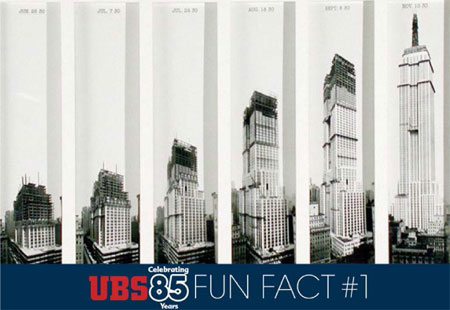
Post 1: Empire State Building, NYC
UBS founder Harold A. O’Callaghan, a Stevens Institute of Technology mechanical engineering graduate, supplied materials for the construction of the Empire State Building. Originally a building supplier (hence the company name), UBS supplied the equipment that held the steel at the right height when pouring the cement. Erected in 1931, the Empire State Building became the first building to exceed 100 stories. The skyscaper went up in less than 14 months, an especially impressive feat when compared to the 2008 renovation in which the Empire State Building’s lobby makeover took four months longer to complete than the entirety of the building construction eight decades earlier.

Post 2: St. Patrick’s Cathedral, NYC
St. Patrick's Cathedral took 21 years to build and was opened in 1879. In 2012, UBS was awarded the scaffolding contract for its restoration. UBS engineered and installed a mobile catwalk system in the attic of the cathedral so that carpenters could work on the entire roof without interruption. UBS engineers designed an intricate scaffolding web throughout the interior and exterior that allowed workers to perform the painstaking restoration work, while visitors continued to safely enjoy daily mass in the sanctuary and marvel at the elaborate process of cleaning and restoring the Cathedral to her rightful glory.
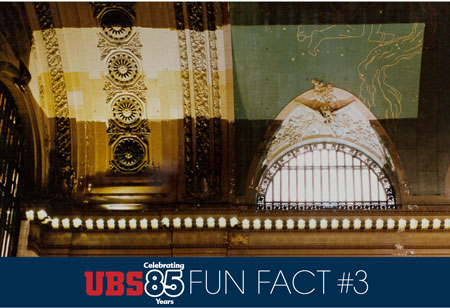
Post 3: Grand Central Terminal Ceiling, NYC
Grand Central Terminal took ten years to complete in 1913 at the staggering cost of $65 million and was declared a National Historic Landmark in 1976 after being rescued from demolition when Jacqueline Kennedy Onassis stepped in to help save the Beaux-Arts building. GCT is known for the astronomical mural on the ceiling of the main concourse, which shows the Mediterranean sky during the October to March zodiac and features 2,500 stars. During its restoration, UBS workers discovered the names of the craftsmen written around the stars in the ceiling. A bonus fun fact: The cleaning of the ceiling was done by air blasting ground walnut shells!
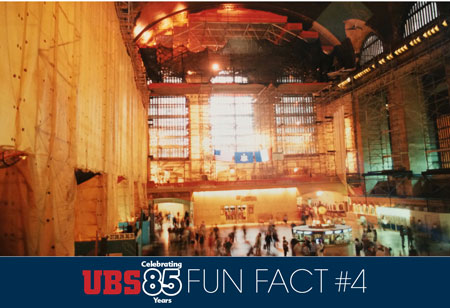
Post 4: Grand Central Terminal Hall, NYC
By 1929, 47 million passengers were passing through the Grand Central Terminal’s Indiana limestone façade. The information booth continues to be a favorite meeting place for commuters and travelers, in large part due to its iconic clock which is estimated to be worth more than $10 million. The staff at the station’s information booth handles more than 1,000 questions an hour! From personal experience, UBS workers can confirm that wearing an orange construction safety vest will also cause people to ask you lots of questions, particularly related to directions.
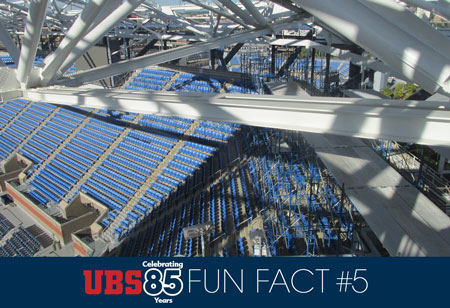
Post 5: Arthur Ashe Stadium, Queens, NY
Arthur Ashe Stadium, named after the winner of the inaugural US Open in 1968, is the largest tennis-specific stadium in the world, holding 23,771 people. When constructing the new steel retractable roof, due to be unveiled for the 2016 US Open, UBS used more than 2,000 scaffold frames, completely encircling the stadium's perimeter. A specialized weather forecast crew will predict when rain is on the way, but the tournament director will make the final call on whether or not to close the roof which takes 5 to 7 minutes.
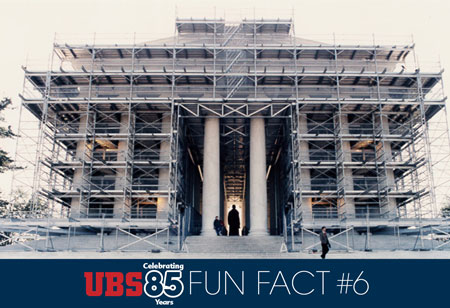
Post 6: Jefferson Memorial
Construction began on the Jefferson Memorial on December 15, 1938 and it was officially dedicated by President Roosevelt on April 13, 1943, the 200th anniversary of Jefferson's birthday. The interior of the memorial has a 19-foot tall, bronze statue shows Jefferson looking back at the statue of Alexander Hamilton, a former rival of his. During the restoration of the Memorial in 1994, UBS designed and erected scaffolding to access areas where repairs of the interior and exterior of the Memorial needed to be made, including the difficult to access curved dome.
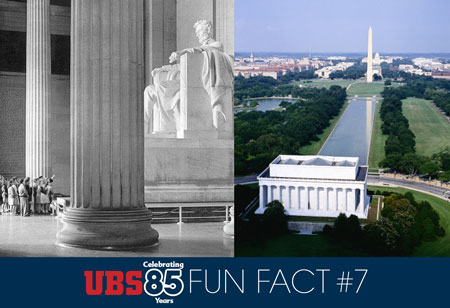
Post 7: Lincoln Memorial, Washington, DC
The 145 steps at the Lincoln Memorial represent “4 score & 7 yrs ago” (87) from President Lincoln’s famous Gettysburg Address, his age at the time of his assassination (56), and the number of presidential terms he served (2). The perimeter of the Lincoln Memorial boasts 36 Doric columns representing the 36 states in the union Lincoln fought to preserve. However, by the time the monument was completed the states had increased to 48 so you will find the remaining 12 states outside the memorial wall. UBS provided access scaffold during the restoration of the Lincoln Memorial in 1994.
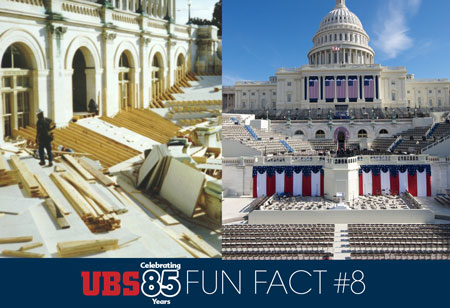
Post 8: Presidential Inaugural Platforms, Washington, DC
Andrew Jackson was the first president to be inaugurated outdoors starting the tradition back in 1829. UBS has built the 10,000 square foot platform for the past four presidential inaugurations. The inaugural platform is constructed every four years, taking three months to install, and is built entirely of lumber to protect the surfaces of the Capitol. After the swearing in ceremony, the platform is carefully deconstructed and the lumber donated to local charities to assist in housing projects.
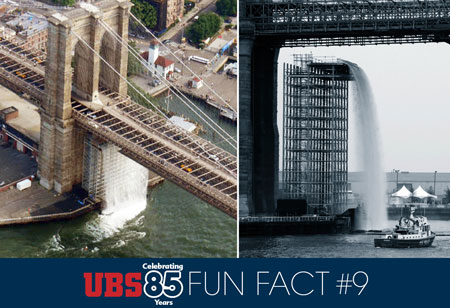
Post 9: NYC Waterfalls | Public Art Project, NYC
UBS provided the scaffolding used as the backbone for the NYC Waterfalls. A Public Art Project by Danish-Icelandic artist Olafur Eliasson, the scaffold weighed 270 tons, more than an average blue whale! The art project was comprised of four manmade waterfalls in the New York harbor that ran from June 26–Oct. 13, 2008, and churned 35,000 gallons of water per minute. The four Waterfalls were located on the East River Esplanade’s Pier 35 in Manhattan; beneath the Brooklyn Bridge in DUMBO, between piers 4 and 5, in Brooklyn; and on Governors Island.
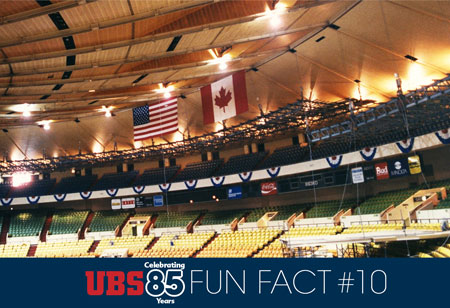
Post 10: Madison Square Garden, NYC
The iconic Madison Square Garden we know today is actually the fourth iteration and opened in 1968 (the original one opened in 1879 closer to Madison Square at Fifth Avenue and 23rd Street). It is the only arena in the world with a concave ceiling, rather than convex. In order to allow events to go on during the three-year renovation in 1989, UBS installed suspended work platforms that were lowered for work on the skybox soffits and raised before events to clear sight lines. 88 new interior skyboxes were installed using this system.
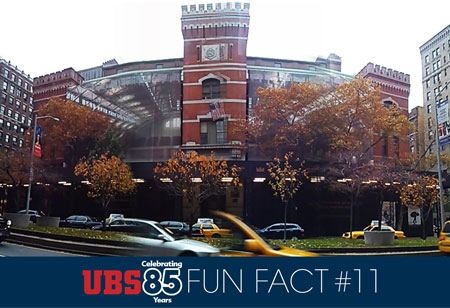
Post 11: Park Avenue Armory, NYC
Park Avenue Armory was built by New York’s prestigious Seventh Regiment of the National Guard—the first volunteer militia to respond to President Lincoln’s call for troops in 1861—who used it as both a military facility and a Social Club. Members of what was known as the “Silk Stocking” Regiment included New York’s most prominent Gilded Age Families including the Vanderbilts, Van Rensselaers, Roosevelts, Stewarts, Livingstons, and Harrimans. In addition to exterior protection, UBS also installed a rolling platform in the immense Wade Thompson Drill Hall so workers could access the ceiling for much needed repair work. Park Avenue Armory is now a groundbreaking cultural institution, and its 55,000 square foot drill hall is the largest unobstructed space of its kind in NYC and is used to present a vast array of visual art installations, music, dance, and theater.
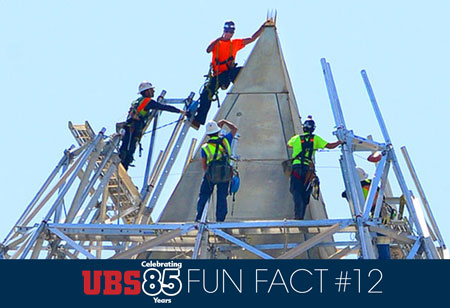
Post 12: Washington Monument, Washington, DC
Built to commemorate George Washington, the first American President, the 555 foot Washington Monument is world’s tallest stone structure and the world’s tallest obelisk. UBS's award-winning scaffold stood 565 feet and was designed, fabricated, and erected by UBS in 1999 and again in 2013. It consisted of 37 miles of aluminum tubing and had a design load in excess of one million pounds to accommodate potential ice and snow loading. The scaffold structure followed the taper of the Monument and was “crowned” with a customized pyramidal structure for the final 65 feet. In May 2013, UBS reinstalled the scaffolding surrounding the Washington Monument, which was required for repairs due to damage sustained in a 2011 earthquake.
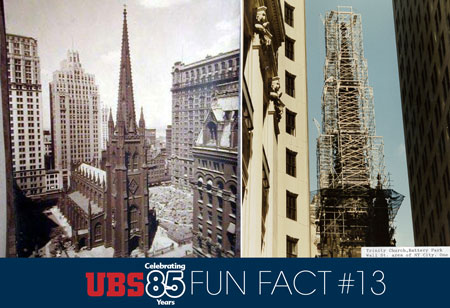
Post 13: Trinity Church, NYC
At the time of the current Trinity Church’s completion in 1846, its 281-foot spire and cross was the highest point in NYC. During the restoration of the steeple exterior, UBS constructed four special anchors that were drilled into the church’s base to support the special scaffolding created to preserve (and prohibit all contact with) the steeple. Those anchors were never removed, and remain embedded in the church’s base to this day.
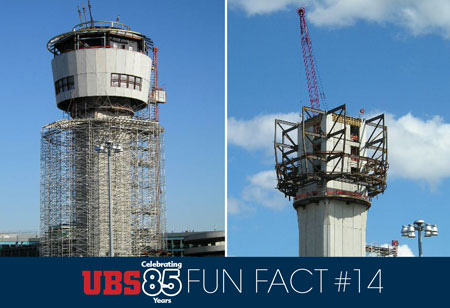
Post 14: FAA Tower at LaGuardia Airport, Queens, NY
Named after Fiorello LaGuardia—the mayor of NYC when the airport was built in 1939. Among pilots, it is referred to as “USS LaGuardia”, because the runways are short and surrounded by water, thus giving the feel of landing on an aircraft carrier. In late 2006, construction began to replace the 1962 air traffic control tower. The new control tower began operations on October 9, 2010. UBS erected an exterior scaffold enclosure that allowed the control tower dome to be constructed.
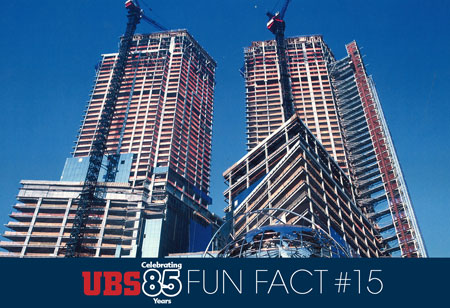
Post 15: Time Warner Cable Headquarters, NYC
Time Warner Cable’s headquarters in NYC is home to Jazz at Lincoln Center and CNN Studios. The 800-foot “twin tower” feature, constructed in the heart of busy Manhattan’s Columbus Circle, was the first major building completed in Manhattan after 9/11, as well as the largest single building hoisting project in the history of Manhattan. The superstructure rose at a rate of one floor every two days. In order to keep up with the fast pace, UBS invented a new cutting-edge hoisting system that was technologically superior and safer allowing approximately 90% of the work to be performed at ground level.
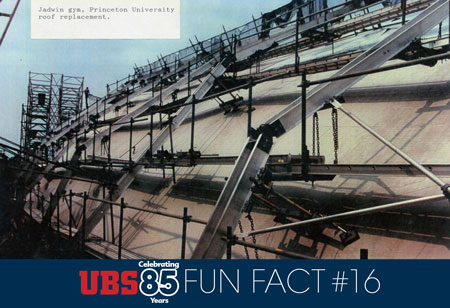
Post 16: Princeton University Jadwin Gym, Princeton, NJ
Named for Leander Stockwell Jadwin, class of 1928, the Princeton University Jadwin Gymnasium has 250,000 square feet of floor space on five levels for multiple sports. Notable for its unique roof consisting of three interlocking shells, UBS designed and constructed scaffolding to follow the unusual line of the curved roof so the workers could walk up and down safely. It was a true feat of engineering!
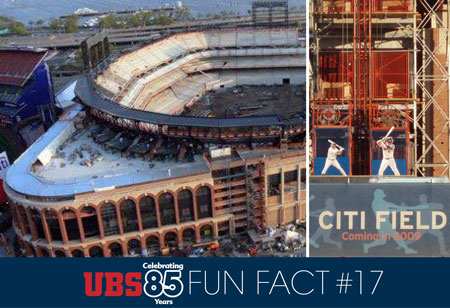
Post 17: Citi Field
Citi Field (named for CitiCorp) was built as a replacement for Shea Stadium, which first opened in 1964 adjacent to the site of the 1964–1965 World’s Fair. The design for the NY Mets Citi Field was largely inspired by Ebbetts Field, which was the home of the Brooklyn Dodgers from 1913–1957. The seats are green in homage to the Polo Grounds, the original home of the Mets’ namesake—the 19th century baseball team named the New York Metropolitans. In 2007, UBS provided scaffold stairs and a material hoist during the construction of the new home of the Mets.
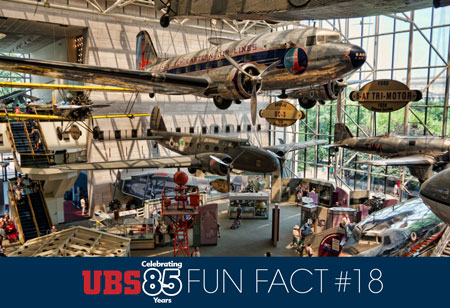
Post 18: The Smithsonian National Air and Space Museum, Washington, DC
The Smithsonian National Air and Space Museum is the largest of the Smithsonian’s 19 museums, and the most visited museum in the country with more than 8 million annual visitors! Among the exhibits are the Wright Brothers’ original 1903 Flyer, the Apollo Lunar module, and Lindbergh’s Spirit of St. Louis. All of the aircraft and spacecraft on display in the Air and Space Museum were actually flown or were used as backup vehicles.
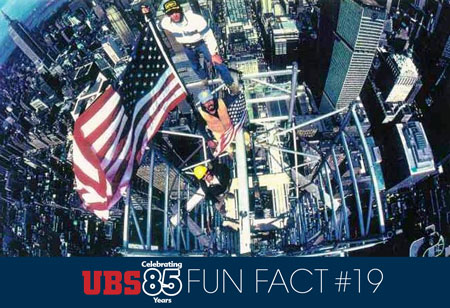
Post 19: Chrysler Building, NYC
Designed for industrial magnate Walter P. Chrysler, the Chrysler Building had a secret plan to become the tallest building in New York by constructing a long spire hidden inside the building, which was deployed overnight in four sections. This claim was short lived, however, as 11 months later the General Motors-backed Empire State Building was redesigned and took the crown back. This classic Art Deco-style skyscraper was Chrysler’s corporate headquarters from 1930s to the 1950s. It was declared a National Historic Landmark in 1976. UBS helped to refurbish the Chrysler Building’s spire in the 1970s using a freestanding access scaffold based on needle beams at the building’s base.
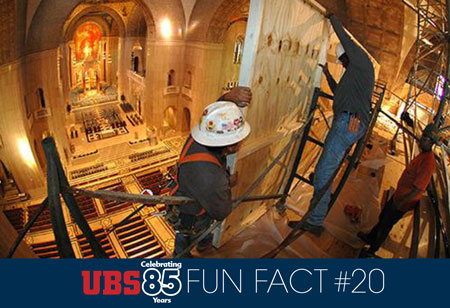
Post 20: The Basilica of the National Shrine of the Immaculate Conception, Washington, DC
The Basilica of the National Shrine of the Immaculate Conception in Washington DC can accommodate up to 6,000 visitors at one time, making it the largest church in America, and one of the top ten largest in the world. With a spire rising 329 feet and standing on a hill that is over 200 feet high, it’s almost as tall as the Washington Monument. Built in the style of medieval churches, the Basilica houses 70 chapels honoring Mary and reflects the origins of Catholic immigrants. In 2005, UBS provided access scaffolding for the Shrine’s restoration.